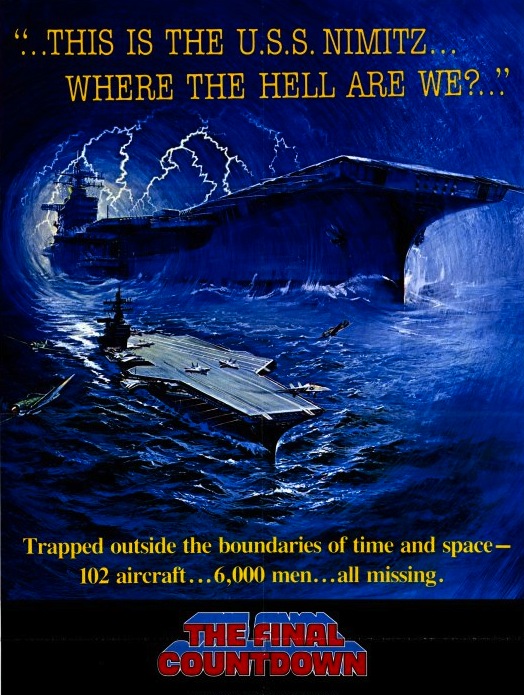Wednesday, August 13, 1980
THE FINAL COUNTDOWN. Written by David Ambrose, Gerry Davis, Thomas Hunter and Peter Powell. Music by John Scott. Directed by Don Taylor. Running time: 103 minutes. Mature entertainment with the B.C. Classifier's warning: some violence, occasional coarse Ianguage and swearing.
Let's go back to the time
when men were men,
And fight the First World War
all over again . . .
when men were men,
And fight the First World War
all over again . . .
— Barry's Boys, by June Reizner
(sung by the Chad Mitchell Trio)
(sung by the Chad Mitchell Trio)
IN OUTLINE FORM, it sounds like an idea left over from TV's Twilight Zone. On December 6th, 1980, the nuclear-powered aircraft carrier Nimitz disappears into a storm off Pearl Harbor. When it re-emerges, it is December 6th, 1941.
On the theatre screen, The Final Countdown looks more like an episode of TV's Star Trek, and a lesser episode at that. "This is the U.S.S Nimitz," it says on the posters. "Where the hell are we?"
Read the fine print and you'll see that three names are credited with the story idea, and four with the screenplay. The final product is an example of committee film-making at its worst.
The Countdown committee started with an interesting enough idea. Here is the kind of "what if . . . ?" that inspires great science-fiction stories. Too bad they had no idea what to do with it.
The film opens with a reclusive industrialist named Tideman watching from the shadows as his employee, systems analyst Warren Lasky (Martin Sheen) ships out for the Nimitz. Once on board, Lasky has a run-in with a jet pilot named Richard Owens (James Farentino), an amateur historian working on a book about the Pacific War, beginning with the Japanese attack on Pearl Harbor.
The ship passes through an unexpected storm, a visual effect that looks for all the world like a colour-tinted shot of a toilet flushing. For the next 20 minutes or so, Captain Matthew Yelland (Kirk Douglas) and his officers dither.
Reconnaissance photos of a pre-war Pearl Harbor and the pre-war Imperial Japanese fleet, coupled with an encounter with a pair of period Japanese fighter aircraft, convince them that they are indeed time travellers. Lasky makes the required speech about unknown forces in the universe and they spend the rest of the movie dithering some more.
Pause for a moment. Consider the present [1980] mood in America. Our good neighbours to the south are desperate for a little reassurance about their military might. The last time we read about the Nimitz in the newspapers, it was in connection with a certain ill-fated helicopter raid into Iran.
Now, consider this quote from the official production notes issued for The Final Countdown. "The star, of course, is the U.S.S. Nimitz, the world's largest nuclear-powered aircraft carrier . . ." From time to time, Canada's Department of National Defense commissions the National Film Board to make documentary short subjects showing off our military hardware. When they turn up in theatres, filmgoers instantly recognize them for what they are — paid advertisements.
To secure the co-operation of the U.S. Departments of Defense and the Navy, producer Peter Vincent Douglas agreed to show off America's military hardware. Although the producer's father, actor Kirk Douglas, gets top billing, the ship is the film's real "star."
Military buffs will, no doubt, enjoy the view from the bridge. Aviation fans will thrill at the endless launchings and landings, the mid-air refuelling and the grossly mismatched dogfight between a pair of vintage Japanese Zeros (provided by The Confederate Air Force)
It was apparent from Douglas's choice of director — 60-year-old Don Taylor, a former actor and TV director whose recent feature film credits include such indifferent fare as The Island of Dr. Moreau (1977) and Damien: Omen II (1978) — that he was more interested in industrial documentary than credible drama. Their Final Countdown may not change history, but it gives the U.S. Navy more or less what it asked for.
The above is a restored version of a Province review by Michael Walsh originally published in 1980. For additional information on this archived material, please visit my FAQ.
Afterword: That "ill-fated helicopter raid into Iran" that I referred to occurred in April, 1980, and was an attempt to resolve a hostage crisis
